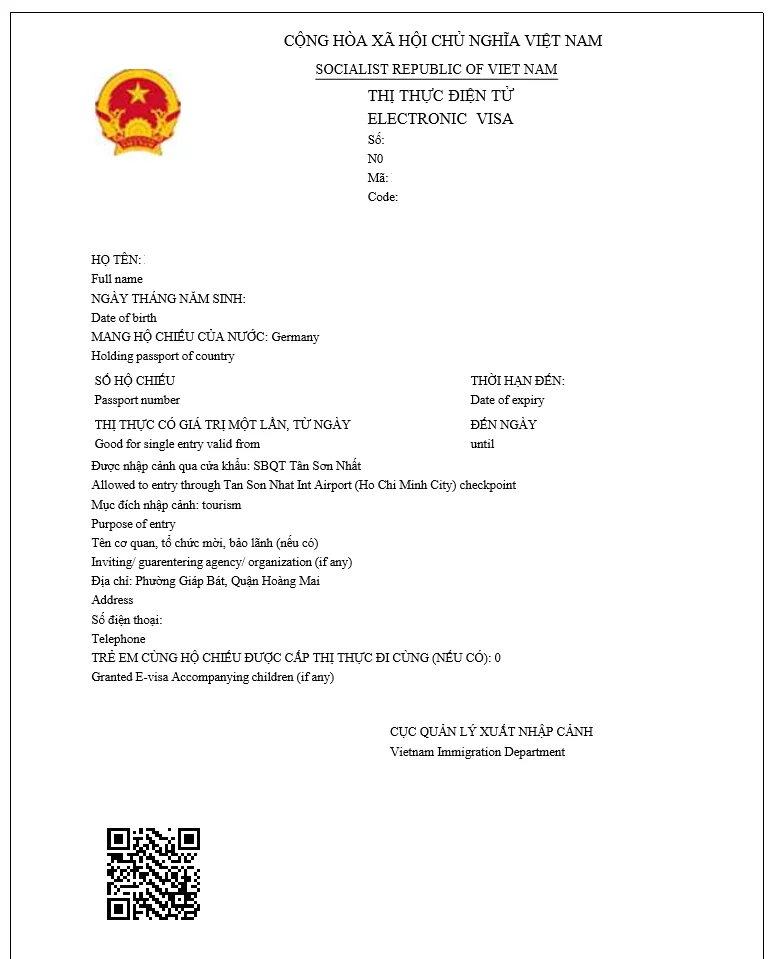Vietnam Visa Eligibility Required
Eligibility for a Vietnam Visa varies. The applicants must have a valid passport issued from the eligible country and qualify according to specific criteria set forth for different visa types. For example, tourists are required to present a travel itinerary. A business traveler needs an invitation letter written by a Vietnam-based organization.
Also, applicants must have a stable finance, though that would be proven through bank statements; sometimes proof of accommodation like hotel reservations is required. Of course, one has to have a clean record otherwise the application may get rejected due to past legal cases.
In addition, your passport should have at least six months' validity from the entry date and at least two pages left for visa stamps. Fill out all the requirements for easy approval. Do not make a mistake nor miss any information as requested on the Vietnam Visa Apply Online website, as the failure to do so will see a delay in getting approval.
Widen Your World - Visa-Free Vietnam Travel for Citizens
The visa-free policies of Vietnam allow passport holders from specific countries to tour the country without the necessity of visas that have been pre-arranged. Those travelers are granted an entry for stays of a lesser duration, usually between 14 to 30 days, according to specific bilateral agreements established.
This policy promotes tourism and eases travel, allowing more visitors to experience Vietnam's iconic sites, such as Ha Long Bay and the bustling streets of Hanoi. For entry, however, travellers need a passport, as well as a proof of onward travel, and so on. For longer stays or other purposes, alternative options are available within the Vietnam Visa Apply Online system.
Why is the Vietnam Visa Application Online Important for VisitsVisa?
Today, the process of Vietnam Visa Apply Online revolutionizes all traditional visa applications, as it offers unprecedented convenience and efficiency. VisitsVisa's online platform allows applicants to complete their visa application from anywhere, eliminating the need for embassy visits and lengthy paperwork.
With step-by-step instructions and with an easy-to-use interface, VisitsVisa allows applicants to upload documents, track application status, and make safe payments. Expedited processing options are also available for customers who need to travel on short notice, reducing waiting times dramatically.
Moving to the digital system, VisitsVisa allows hassle-free application for a Vietnam Visa, which makes travel experiences freer. That way, there is effective utilization of applicant's time spent on administrative pursuits and more time preparing for their trip to Vietnam. It is thus a preferred site for a Vietnam Visa online, recognizing its security and reliability.





 Qatar
Qatar  Kuwait
Kuwait Oman
Oman Yemen
Yemen Saudi Arabia
Saudi Arabia  Bahrain
Bahrain Egypt
Egypt India
India  Turkey
Turkey Romania
Romania Russia
Russia Ukraine
Ukraine United Kingdom
United Kingdom Canada
Canada  United State of America
United State of America  Singapore
Singapore Malaysia
Malaysia  Japan
Japan  Thailand
Thailand  Mexico
Mexico  Hong Kong
Hong Kong  Philipines
Philipines Vietnam
Vietnam  Armenia
Armenia  kazakhstan
kazakhstan  Australia
Australia New Zealand
New Zealand South Korea
South Korea South Africa
South Africa Uganda
Uganda Ghana
Ghana Kenya
Kenya Sudan
Sudan Morocco
Morocco Syria
Syria Lebanon
Lebanon Iran
Iran Iraq
Iraq Austria
Austria  Belgium
Belgium The czech republic
The czech republic Denmark
Denmark Finland
Finland France
France Greece
Greece Iceland
Iceland Italy
Italy Latvia
Latvia Liechtenstein
Liechtenstein Lithuania
Lithuania Luxembourg
Luxembourg Malta
Malta Norway
Norway Poland
Poland Slovakia
Slovakia Slovenia
Slovenia Sweden
Sweden Switzerland
Switzerland Afghanistan
Afghanistan Albania
Albania Algeria
Algeria American Samoa
American Samoa Andorra
Andorra Angola
Angola Anguilla
Anguilla Bangladesh
Bangladesh  Barbados
Barbados  Belarus
Belarus  Belize
Belize  Benin
Benin  Bermuda
Bermuda  Bhutan
Bhutan  Bolivia
Bolivia  Bosnia and erzegovina
Bosnia and erzegovina  Botswana
Botswana  Brazil
Brazil  Brunei
Brunei  Bulgaria
Bulgaria  Burkina Faso
Burkina Faso  Burundi
Burundi  Cambodia
Cambodia  Central African public
Central African public  Chad
Chad  Chile
Chile  Colombia
Colombia  Comoros
Comoros  Cook Islands
Cook Islands  Costa Rica
Costa Rica  Croatia
Croatia  Cuba
Cuba  Cyprus
Cyprus  Democratic Republic of Congo
Democratic Republic of Congo Djibouti
Djibouti  Dominica
Dominica  Equatorial Guinea
Equatorial Guinea  Eritrea
Eritrea  Ethiopia
Ethiopia  Faroe Islands
Faroe Islands  Fiji
Fiji  Gabon
Gabon  Gambia
Gambia  Georgia
Georgia  Greenland
Greenland  Grenada
Grenada  Guadeloupe
Guadeloupe  Guam
Guam Guyana
Guyana  Haiti
Haiti  Honduras
Honduras  Indonesia
Indonesia  Ireland
Ireland  Jamaica
Jamaica  Jordan
Jordan  Kiribati
Kiribati  Kosovo
Kosovo  Kyrgyzstan
Kyrgyzstan  Laos
Laos  Lesotho
Lesotho  Liberia
Liberia  Libya
Libya  Macau
Macau  Madagascar
Madagascar  Malawi
Malawi  Maldives
Maldives  Mali
Mali  Marshall Islands
Marshall Islands  Martinique
Martinique  Mauritania
Mauritania  Mauritius
Mauritius  Mayotte
Mayotte  Micronesia
Micronesia  Maldova
Maldova  Mongolia
Mongolia  Montenegro
Montenegro  Mozambique
Mozambique  Myanmar
Myanmar  Namibia
Namibia  Nauru
Nauru  Nepal
Nepal  Nicaragua
Nicaragua  Niger
Niger  Nigeria
Nigeria  Norfolk Island
Norfolk Island  North Korea
North Korea  North Macedonia
North Macedonia Pakistan
Pakistan  Palau
Palau  Palestine
Palestine  Panama
Panama  Papua New Guinea
Papua New Guinea  Paraguay
Paraguay  Peru
Peru  Puerto Rico
Puerto Rico  Republic of the Congo
Republic of the Congo  Reunion
Reunion  Rwanda
Rwanda  Saint Helena
Saint Helena  Saint Kitts and Nevis
Saint Kitts and Nevis  Saint Lucia
Saint Lucia  Saint Vincent and the Grenadines
Saint Vincent and the Grenadines  Samoa
Samoa  San Marino
San Marino  Sao Tome and Principe
Sao Tome and Principe  Senegal
Senegal  Serbia
Serbia  Seychelles
Seychelles  Sierra Leone
Sierra Leone  Solomon Islands
Solomon Islands  Somalia
Somalia  South Sudan
South Sudan  Sri Lanka
Sri Lanka  Suriname
Suriname  Swaziland
Swaziland  Taiwan
Taiwan  Tajikistan
Tajikistan  Dubai
Dubai  India
India  Netherland
Netherland Portugal
Portugal Slovenia
Slovenia Antigua and Barbuda
Antigua and Barbuda Argentina
Argentina  Aruba
Aruba  Bahamas
Bahamas  Cameroon
Cameroon  Cape Verde
Cape Verde  Cayman Islands
Cayman Islands  China
China  Dominican Republic
Dominican Republic  Ecuador
Ecuador  El Salvador
El Salvador  Guatemala
Guatemala  Guinea
Guinea  Guinea Bissau
Guinea Bissau  Ivory Coast
Ivory Coast  Morocco
Morocco  New Caledonia
New Caledonia  Zambia
Zambia  Zimbabwe
Zimbabwe  GCC
GCC EU
EU Schengen
Schengen Timor-Leste (East Timor)
Timor-Leste (East Timor)